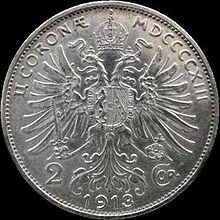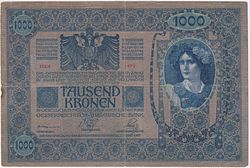Austro-Hungarian krone
Currency of Austria-Hungary, 1892–1918 From Wikipedia, the free encyclopedia
The krone (alternatively crown; German: Krone, Hungarian: korona, Italian: corona, Polish: korona, Slovene: krona, Serbo-Croatian: kruna, Czech: koruna, Slovak: koruna, Romanian: coroană, Ukrainian: корона) was the official currency of Austria-Hungary from 1892 (when it replaced the gulden as part of the adoption of the gold standard) until the dissolution of the empire in 1918. The subunit was one hundredth of the main unit, and was called a Heller in the Austrian and a fillér in the Hungarian part of the Empire.
This article needs additional citations for verification. (October 2015) |
| Österreichisch-ungarische Krone (German) Osztrák–magyar korona (Hungarian) Corona Austro-Hungarica (Latin) Rakousko-uherská koruna (Czech) Korona austro-węgierska (Polish) Австро-угорська корона (Ukrainian) Corona austro-ungarica (Italian) Avstro-ogrska krona (Slovene) Austro-ugarska kruna / Аустроугарска круна (Serbo-Croatian) Rakúsko-uhorská koruna (Slovak) Coroană austro-ungară (Romanian) | |||||
|---|---|---|---|---|---|
| |||||
| Unit | |||||
| Plural | kronen (in German) | ||||
| Symbol | K, kr | ||||
| Denominations | |||||
| Subunit | |||||
| 1⁄100 | Heller (German) fillér (Hungarian) | ||||
| Banknotes | 1, 2, 10, 20, 25, 50, 100, 200, 1,000, 10,000 Krone(n) | ||||
| Coins |
| ||||
| Demographics | |||||
| Date of introduction | 1892 | ||||
| Replaced | Austro-Hungarian gulden | ||||
| Date of withdrawal | 1918/1919 | ||||
| User(s) | West Ukrainian People's Republic | ||||
| Issuance | |||||
| Central bank | Austro-Hungarian Bank | ||||
| This infobox shows the latest status before this currency was rendered obsolete. | |||||
Name


The official name of the currency was Krone (lit. 'crown', pl. Kronen) in Austria and korona in Hungary. The Latin form Corona (plural Coronæ), abbreviated to Cor. on the smaller coins, was used for the coinage of the mostly German-speaking part of the empire known as Cisleithania. Currency names in other ethnic languages were also recognised and appeared on the banknotes: koruna (pl. korun) in Czech, korona (pl. korony) in Polish, корона, korona (pl. корон, koron) in Ukrainian, corona (pl. corone) in Italian, krona (pl. krone) in Slovene, kruna/круна (singular and plural) in Serbo-Croatian, koruna (pl. korún) in Slovak, and coroană (pl. coroane) in Romanian. These terms all translate to the English word crown.
The symbol of the currency was the abbreviation K. or sometimes Kr.
History
Summarize
Perspective
Introduction
After several earlier attempts the Austro-Hungarian Empire adopted the gold standard in 1892 according to a plan drawn up by the Hungarian Minister of Finance Sándor Wekerle. This plan included the introduction of the new currency, the Krone. It consisted of 100 Heller (Austria) or Fillér (Hungary). The value of the Krone was set at 2 kronen = 1 gulden. From 1900 onward, Krone notes were the only legal banknotes of the Empire.
First World War
The currency depreciated sharply as a result of the First World War, which was financed mostly by the issue of War Bonds rather than through taxation. Consumer prices rose sixteenfold during the war, as the government had no hesitation in running the Austro-Hungarian Bank's printing presses to pay its bills: this triggered a higher inflation rate than in other combatant countries.
After 1918
Austria
After the end of the First World War it was initially hoped that the Krone might remain the common currency of the Empire's successor states, but in January 1919 the Kingdom of Serbs, Croats, and Slovenes (later Yugoslavia) became the first successor state to overstamp the Austro-Hungarian Bank's notes, limiting their validity to its own territory. Czechoslovakia followed suit in February 1919, and on 12 March 1919 the new Republic of Austria stamped the notes circulating in its territory with "DEUTSCHÖSTERREICH".
The Austrian economy did not stabilise after the war, and a period of hyperinflation followed: the money supply increased from 12 to 30 billion Kronen in 1920, and to about 147 billion Kronen at the end of 1921. In August 1922 consumer prices were 14,000 times greater than before the start of the war eight years earlier. The highest-denomination banknote issued was the 500,000 Kronen note, issued in 1922. Faith in the currency had been lost, and people spent money as fast as they received it. In October 1922 Austria secured a loan of 650 million gold Kronen from the League of Nations, with a League of Nations Commissioner supervising the country's finances. This stabilized the currency at a rate of 14,400 paper Kronen to 1 gold Krone. On 2 January 1923 the Austrian National Bank (Österreichische Nationalbank) began operations, taking over control of the currency from the Austro-Hungarian Bank which had gone into liquidation.
In December 1923 the Austrian Parliament authorised the government to issue silver 5,000, 10,000, and 20,000-kronen coins which were to be designated half-Schilling, Schilling, and double Schilling. The Schilling became the official currency of Austria currency on 20 December 1924, at a rate of 10,000 Kronen to 1 Schilling.
Banknotes
| Pick No. | Front | Back | Year of Issue | Denomination | Additional Notes |
|---|---|---|---|---|---|
| Issued by the Austro-Hungarian Bank | |||||
| 1 |  |  | 1880 | 10 Gulden | |
| 4 |  |  | 1900-1902 | 10 Kronen | |
| 5 |  |  | 1900-1902 | 20 Kronen | |
| 6 |  |  | 1900-1902 | 50 Kronen | |
| 7 |  |  | 1900-1902 | 100 Kronen | |
| 8a |  |  | 1900-1902 | 1000 Kronen | Gray-green underprint. |
| 8b |  |  | 1900-1902 | 1000 Kronen | Rose underprint. Later issue from Series #1440 onward. |
| 9 |  |  | 1904-1912 | 10 Kronen | |
| 10 |  |  | 1904-1912 | 20 Kronen | |
| 11 |  |  | 1904-1912 | 100 Kronen | Pictures woman with flowers. |
| 12 |  |  | 1904-1912 | 100 Kronen | |
| 13 |  |  | 1913-1914 | 20 Kronen | |
| 14 |  |  | 1913-1914 | 20 Kronen | Like #13 but with II AUFLAGE (2nd issue) at left border. |
| 15 |  |  | 1913-1914 | 50 Kronen | |
| 17a |  |  | 1914-1915 | 2 Kronen | Thin paper, series A or B. 2 serial # varieties. |
| 17b | 1914-1915 | 2 Kronen | Heavier paper, series C. | ||
| 19 |  |  | 1914-1915 | 10 Kronen | |
| 20 |  |  | 1916-1918 | 1 Krone | |
| 21 |  |  | 1916-1918 | 2 Kronen | |
| 23 |  |  | 1916-1918 | 25 Kronen | |
| 24 |  |  | 1916-1918 | 200 Kronen | |
| 25 |  |  | 1916-1918 | 10,000 Kronen | |
| Issued by the Kriegsdarlehenskasse (War Loan Office) | |||||
| 26 | 1914 | 250 Kronen | |||
| 27 | 1914 | 2000 Kronen | |||
| 28 | 1914 | 10,000 Kronen | |||
| 29 | 1918-1919 | 1,000 Kronen | |||
Coins
Over-stamped Austro-Hungarian krone
Summarize
Perspective
Croatia, Slovenia and Bosnia and Herzegovina
In these territories of Austria-Hungary, which became part of the Kingdom of the Serbs, Croats and Slovenes (later Yugoslavia) in 1918, Krone banknotes were stamped by the new authorities and became issues of the Serb, Croat and Slovene krone. In 1920 this was replaced by the dinar at a rate of 1 dinar = 4 Kronen.
Czechoslovakia
In Czechoslovakia the currency was superseded by the Czechoslovak koruna, at par. The names of the present-day koruna and haléř (in the Czech Republic) and the pre-Euro koruna and halier (in Slovakia) are derived from the Austro-Hungarian Krone and Heller.
Fiume
10 Fiume krone provisional banknote (1920)
The Fiume Krone (Corona Fiumana) - (Cor., FiuK) was introduced on 18 April 1919 by over-printing the existing Austro-Hungarian Krone notes, under the authority of the Italian National Council of Fiume who ruled the city. There were two issues: the 1919/21 Issue (1 and 2 kronen),[4] and the 1920 Issue (2, 10, 20, 50, 100, and 1,000 kronen).[5] The over-printed notes were in circulation from April 1919 to February 1921.[6] In September 1920 the Italian Lira was introduced as the official currency. The unofficial exchange rate to the lira was 2.5 FiuK to 1 Lira.
Hungary
In Hungary the Austro-Hungarian currency was overstamped and then replaced by the Hungarian korona at par. The Hungarian korona was devalued by hyperinflation, due to the consequences of World War I and the Treaty of Trianon. It was replaced by the pengő on 21 January 1927, at a rate of 12,500 korona to 1 pengő.
Romania
10 Romanian kronen provisional banknote (1919)
In Romania there were two issues of over-stamped notes: the 1919 First Provisional Issue (stamp on the Austrian side of the note), and the 1919 Second Provisional Issue (stamp on the Hungarian side).[7] Both issues included 10, 20, 50, 100, 1000, and 10,000 korona denominations.[7] The issue dates of the base Austro-Hungarian krone notes used ranged from 1902 to 1918.[7]
Complete denomination sets of over-stamped notes
| Value | Czechoslovak | Hungarian | Size | Base date |
|---|---|---|---|---|
| 10k | 150x79mm | |||
| 20k | 150x89mm | |||
| 25k | Not issued |
135x80mm | ||
| 50k | 162x100mm | |||
| 100k | 163x107mm | |||
| 200k | Not issued |
168x100mm | ||
| 1,000k | 191x127mm | |||
| 10,000k | Not issued |
191x127mm |
Historic exchange rates and prices
This section needs additional citations for verification. (October 2015) |
| Year | Rates |
|---|---|
| 1892 |
|
| 1896 |
|
| 1899 |
|
| 1900 |
|
| 1907 |
|
| 1909 |
|
| 1913 |
|
| 1914 |
|
| 1915 |
|
| 1916 |
|
| 1917 |
|
| 1918 |
|
| 1919 |
|
| 1921 |
|
Coins
Banknotes
Krone banknotes were designed and printed in Vienna from 1900 onward. These banknotes were used throughout the Monarchy. All banknotes issued by the Austro-Hungarian Bank were bilingual in German and Hungarian: the denomination was also indicated in other languages of the Monarchy. Until World War I, all banknotes had a German and a Hungarian side; during the war, some banknotes were issued with text in both languages on either side. The designers included Koloman Moser, Rudolf Rössler, Josef Pfeiffer and László Hegedűs. The engraver was Ferdinand Schirnböck.
References
External links
Wikiwand - on
Seamless Wikipedia browsing. On steroids.
















